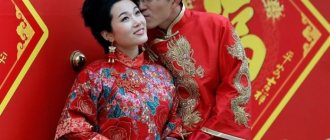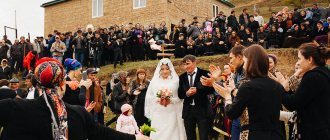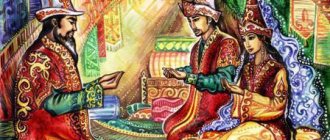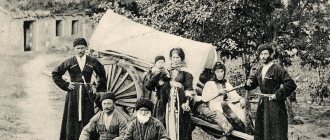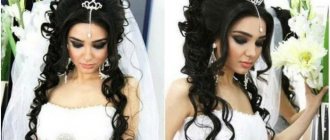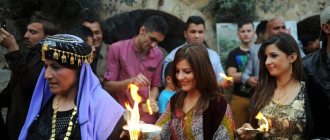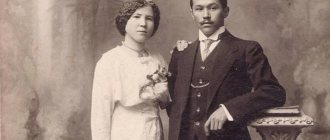A Korean wedding is distinctive and embodies the unique culture of this people with a complex history. Established traditions are very important for Koreans; breaking them means bringing shame and misfortune upon yourself and your family. Modern wedding rituals in Korea are a fusion of customs and modern trends that have been revered for thousands of years, formed relatively recently, in the 50s of the last century.
In some aspects of the wedding ritual, modern young people have received the greatest possible freedom. For example, more and more families are being created out of mutual love, and not through the collusion of older relatives. But the ancient ban on the marriage of people with the same “phoy” - the designation of a branch of the family, simply put, namesakes, is still unshakable. Even if family ties have been lost for decades or even centuries, the boy and girl will not receive permission to marry. In the eyes of others, they were and remain close blood relatives.
Ancient customs of the Korean people
The Korean people have very strong family ties. They absorb honor and respect for elders from childhood, along with fairy tales and legends. Signs, beliefs and a penchant for mysticism permeate all areas of life. Particular attention is paid to everything related to family and children. Until now, in Korea it is not considered something out of the ordinary to consult a fortuneteller about the most favorable day and hour for a wedding. And in ancient times, choosing the time of wedding celebrations was a very responsible matter and could not be done without the help of a venerable fortuneteller.
Weddings - chunme - were played by agreement between families; in most cases, the young people did not even see each other until the wedding ceremony. The youth's older relatives themselves, or with the help of a matchmaker, looked for a couple among suitable girls who had reached marriageable age. Moreover, the requirements for the future bride were quite strict. Not only character, beauty, physique and ability to behave were taken into account, but also equal social status, family wealth, reputation and skills. For their part, the girl’s parents could have made matchmakers from an unwanted family.
Unusual and interesting: features of Korean celebrations
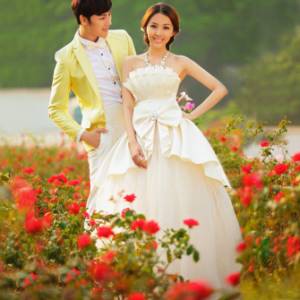
Korean traditions are varied and sometimes incomprehensible to the Russian layman; after a wedding, for example, a young wife changes her surname to the surname of her husband, but children born in their family will definitely be registered in their father’s surname. At the Korean holiday, you cannot hear the familiar “Wedding March”; their newlyweds prefer to tie the knot to a different music, a march created by Wagner.
The priest, who is invited to the ceremony, not only reads the standard text of the wedding oath, he also tells the guests about the life of the newlyweds: their work, strengths and weaknesses, education and preferences. After which he wishes them a long and happy marriage and solemnly declares them husband and wife. The fundamental forces designed to protect Korean families are natural principles - the male “yang” and the female “yin”.
At a wedding, newlyweds do not kiss, because in Korea, expressing your feelings in public is not only not accepted, but also illegal. This is very unusual for us, but a common occurrence in Asian countries. What is a substitute for a kiss? The bride simply takes a sip from her husband's cup or glass.
I would like to clarify that matchmaking among Koreans never takes place without some kind of demonstration of the young people’s achievements. Since the average age of people getting married is 30 years for men, and 25-27 for women. And as you know, by this moment a person already has almost everything necessary to be able not only to create, but also to support his family. Koreans rely on a reasonable approach in everything, and weddings are no exception.
When planning to attend a formal banquet at a Korean wedding, the mother of the groom must wear a traditional hanbok outfit in blue, and the mother of the future bride in soft pink. Everyone, absolutely everyone, must wear white gloves during the ceremony, as Korean wedding etiquette dictates. The closest relatives and friends insert small boutonnieres into the buttonhole on the chest. The bride behaves more than modestly at the banquet. Constantly lowered gaze, bowed head, expression of meekness and submission before the future life and spouse. The ability to constantly be in the shadow of a spouse is still considered a special advantage of Korean women.
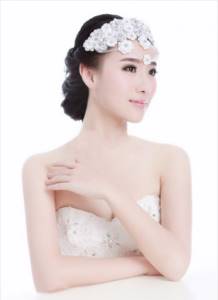
When, after the completion of the main part of the event, all the invitees go to the banquet, the young people do not go with them. A formal dinner is usually held in a restaurant, or in a banquet company where one of the spouses works. The newlyweds go to a specially decorated room “phyebeksil”, where they greet the parents and other relatives of the groom who had gathered there in advance. For this ritual, the young couple dresses in national Korean wedding dresses. There is also a small banquet table in the room, on which, among the treats and drinks, there must be jujube fruits.
In order of seniority, the bride and groom go around the seated relatives and, ritually bowing, pass each a bowl of alcohol. According to tradition, this round begins with the father of the groom, who is supposed to be greeted with two bows to the ground and one to the waist. Everyone else is given one bow to the ground and one bow from the waist.
Preparatory period of Sangyeongne
Modern Korean boys have the opportunity to meet and communicate with girls they like, which was considered obscene until the 60s of the last century. Often, a professional matchmaker is hired to find a soul mate. The most favorable period for marriage is considered to be from 24 to 27 years.
Before starting a serious relationship, young people notify their parents or older relatives of their serious intentions. In Korea, it is believed that the experience and wisdom of the older generation will prevent you from making a mistake and throwing in your lot with an unsuitable party. The search for a future spouse and the assessment of his or her qualities are treated with the utmost care, because divorce in Korea is almost unthinkable.
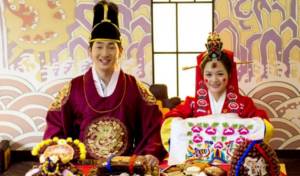
First acquaintance and matchmaking ritual
Since a wedding in Korea is a matter of great importance, with a lot of nuances, both families are given time to prepare. As a rule, at least six months pass from the moment of agreement to the actual wedding celebrations. If the parents come to an agreement at the preliminary sogethin meeting, the young man’s family can begin the matchmaking ritual.
Matchmakers are usually appointed by close senior relatives of the young man: father, uncles, older brothers. The main thing is that they have an odd sacred number - 3, 5 or 7. Candidates must have a positive outlook on life and be distinguished by worldly wisdom. This is a great honor and considerable responsibility, so there is an unspoken struggle for the place of matchmaker. As a rule, the most respected members of the clan are chosen.
Matchmakers come to the house of the bride's parents and discuss the upcoming celebrations, as well as the nuances of future family life.
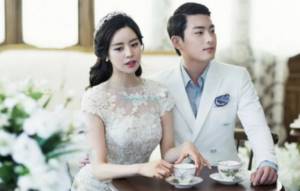
Celebration
Koreans have established a tradition of celebrating weddings in esikjang. This is the name of the ritual hall, intended specifically for weddings.
A restaurant is often chosen as a wedding venue. It is relatively rarely celebrated at home.
The Ministry of Social Security charges a fee for using esikjang. Since Koreans invite quite a lot of guests to their weddings, they tend to hold the celebration on Saturday or Sunday so that everyone can come.
Therefore, the price for renting a hall on weekdays is reduced by half. The state strictly monitors this.
The newlyweds celebrate their wedding in Western-style outfits - a tailcoat and a luxurious snow-white dress. These clothes are often rented. Rings are not given as much importance as in other countries.
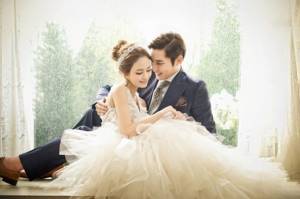
A wedding is a rather expensive event. The custom of giving money to young people as a gift helps reduce this financial burden.
Here it should be noted that social activity is the basis of the life of any Korean, who from the moment of birth to adulthood accumulates many connections and acquaintances, their number reaches several hundred and accumulates throughout life. Moreover, all these connections must be maintained, which is a difficult task simply due to lack of time.
So, absolutely all relatives, friends and acquaintances are invited to the wedding, although not everyone is present at the wedding. But without exception, all those invited present money to the young people as a gift.
In modern South Korea, there are even special “wedding” applications for smartphones through which guests can make a transfer.
Usually there is a person at the entrance to the hall who accepts signed envelopes with money and adds to the list who gave how much. The amounts can vary greatly, but on average it is 50-100 dollars.
The main thing for newlyweds is not to forget the amount of the gift and make an appropriate reciprocal contribution in the event of the subsequent wedding of the invited guest.
You can read more about the interesting features of the Korean way of life and their traditions here.
At the beginning of the event, the bride is in a special room, the groom and parents greet the guests. Guests can come in and take photos with the bride.
In the ceremony hall, chairs are placed on both sides of the aisle. The groom's guests are sitting on the left, and the bride's on the right. In the front row are the parents' seats of honor.
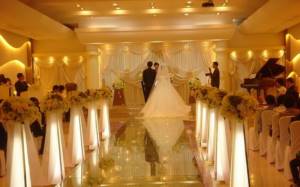
There is another very respected person at the celebration - this is the manager. The newlyweds choose him from among their most influential and respected acquaintances.
The traditional ceremony lasts about half an hour. The mothers of the newlyweds enter first and light candles at the dais intended for the ceremony.
The groom enters the hall, followed by the bride, looking at the floor, which personifies her modesty. She is accompanied by her father or eldest relative.
The groom greets his father-in-law, and to the accompaniment of Wagner’s “Wedding March” he takes his bride and leads him to the podium. The manager gives them a short speech, which is the main point for which everyone has gathered.
First, he invites the newlyweds to take an oath to live in love and harmony, and upon hearing an affirmative answer, he declares the newlyweds husband and wife.
This is followed by a list of the merits of the young people, they are praised and wished for happiness. In response, the young people bow to everyone present in order:
- parents of the bride;
- the groom's parents;
- guests.
After this, the festive lunch begins. At this time, the newlyweds, in a separate small room in traditional Korean attire, pay respects to the groom’s relatives.
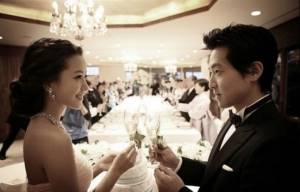
“Little wedding” or bridesmaid ceremony
At the request of the girl’s older relatives, families can hold a “chenchi”, a preliminary wedding in a narrow circle, after which the newlyweds are already considered husband and wife. And later there are big celebrations. At this wedding, which always takes place in the bride's house, the groom goes through a series of difficult tests. They ask him tricky questions, make fun of him and put him in an awkward position.
Representatives of the groom's family present the girl with rich gifts: luxurious fabrics, jewelry, household items and clothing. At the same time, you won’t be able to get away with just one general gift. Each of those present must give personally, with obligatory good wishes. The next day, the bride presents reciprocal gifts to all participants in the small wedding.
On the eve of the wedding, a small feast for close relatives is held at the groom's house. Having tasted the treat and accepted congratulations, the groom kneels in a respectful position and bows low to his parents, thanking them for their birth and upbringing. Thus the young man enters adulthood.
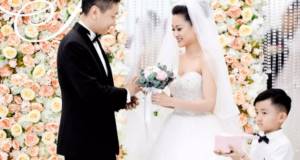
Wedding preparations
They prepare for a wedding in Korea very carefully. First of all, gifts are collected from the groom's relatives for all the bride's relatives and friends. These gifts are given from a specific person, and not from the entire family. The following are used as gifts:
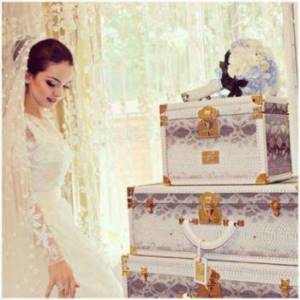
- pieces of expensive material;
- watch;
- services;
- clothes.
If the wedding day has not been set, then the main celebration coincides with the chenchi, and the mini-wedding turns into a real full-fledged celebration. Whose side (the bride or groom) is celebrating the chenchi is decided by the elders during matchmaking. If this right is granted to the bride’s side, then all relatives and friends, colleagues, neighbors, and friends will be invited. If the chenchi is hosted by the groom's side, then the bride's relatives will have to organize a return reception, where the wedding day (if one will be held) will be set.
A return reception is necessary in order to thank those representatives of the groom's family who gave gifts to the bride and her relatives.
Traditional wedding celebrations
Marriage in Korea is usually carried out at home, on the territory of the bride’s family nest. The newlyweds dress in traditional or classic costumes - as desired. They are brought to the site equipped in the courtyard in special “gamma” niches, decorated with peonies. After the wedding ceremony is over, the newlyweds bow deeply to each other and drink wine.
Bride ransom
Before the ceremony begins, the groom must ransom the bride. This custom has ancient roots and is still observed today, taking on a more modern form. In the yard and on the doorstep, the guy is met by numerous single relatives and girlfriends of the girl. They all need to be buttered up with gifts. Little ones are bribed with sweets, but older ones won’t refuse money. Only after breaking through the human cordon can the groom finally enter the house and see his bride. If the “wushi” accompanying the groom has a good tongue and can talk the people out, then the size of the ransom is significantly reduced. Sometimes, if you are lucky or the “usi” reveals something interesting, the girl can be given away without any financial ransom at all.
Another way to get through to a girl without leaving half of your fortune in the pockets of numerous petitioners is to fight with one of her older brothers. Now it is more of a stylized performance, providing a lot of positive emotions to both the participants in the “battle” and the audience. Previously, the duel was intended to test the real military skills of the groom, his ability to protect his beloved and children.
Celebration at the bride's house
When the ransom is received from the groom, the whole company sits down at the table. The newlyweds are seated in places of honor, guests and relatives are seated according to their position. The girl is given good advice and instructions: to be an exemplary housewife, to obey her husband. During the feast, the girl's dowry is given to the groom. After the end of the small feast, the whole company, together with a rich dowry, moves together to the groom's house.
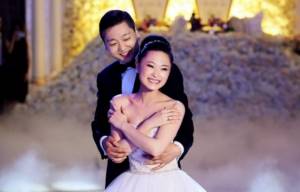
Wedding feast
Favorite performers are usually invited to provide musical accompaniment to the banquet. Sometimes relatives and guests themselves can create a concert program, an amateur performance, so to speak. However, they do not deny themselves the pleasure of singing or dancing on stage, even in the presence of professional singers and groups. This kind of pastime is considered the main highlight of a Korean wedding. Each speaker, even if a bear has stepped on his ear and trampled on his feet, is rewarded with a storm of applause - for his efforts.
Gifts for young people, as in the East in general, are money in all forms: cash in envelopes, checks, gift certificates, and the like. It is not customary to give household appliances or vases and dishes of your choice purchased in stores for a wedding, and this happens extremely rarely.
The tables are literally bursting with a variety of goodies. Elite drinks, plentiful snacks, hot dishes, exotic fruits and sweets of all kinds are an indicator of prosperity and a guarantee of a future comfortable life for the young. A whole boiled rooster must be present. Usually all food is purchased at the expense of the groom's family, this is how they demonstrate wealth.
Kissing at weddings in Korea is not only discouraged, but also prohibited by law. The maximum that young people can afford amid cries of “Bitter!” - This is eating a piece of marmalade or date together.
Bride's visit to the groom's house
After the ransom, the groom is given the bride's dowry in the presence of the entire retinue of the young man. The bride’s parents also give her life instructions and advice on family life.
Every parent tries to make sure their children have the best Korean wedding. The newlyweds are expected to visit the groom's house. Koreans have a wedding tradition of visiting the groom's home with the bride and her dowry, meaning that she is now part of his family as well. There should always be a bag of rice on the doorstep of the house, since rice for Koreans symbolizes a well-fed life. The bride, arriving at her mother-in-law's house, must step over this bag and carefully walk along a silk path, which is laid specially before her arrival. This path is a symbol of wealth and prosperity.
The bride's dowry must include a mirror, since it is in this mirror that the bride and mother-in-law must look together during her arrival at the groom's house, so that in the future there will never be quarrels or disagreements between them. When the bride has already entered the house and her mother-in-law has received her, the girl’s dowry can also be entered.
Wedding signs and traditions of the Korean people
The culture of each people is the quintessence of the invaluable experience of hundreds of generations living in the same territory. The wisdom of the ancestors is expressed in unspoken customs that are not written down anywhere, which, nevertheless, are sacredly observed.
- Family for Koreans is sacred. A man or woman who had not found a mate before the age of thirty was considered strange. They tried to marry such people as quickly as possible with the first more or less suitable candidate. A wedding in Korea is a union of two families, and not just a marriage between young people, so they are very picky when choosing a couple.
- The parents of the future couple meet on neutral territory, usually in a restaurant, where a preliminary acquaintance of the families takes place. Mutual requirements for candidates are put forward, psychological portraits of young people are discussed. A mutual report on physical condition, with the presentation of certificates, is also one of the mandatory points. After all, the health of future grandchildren depends on this! Only after this is a decision made: to have a wedding or not.
- Exactly 70 days before the wedding, the girl must give the family of her betrothed a piece of silk. In the old days, such a gift was truly precious and personified respect for new relatives. Nowadays, fabric is very often replaced with any other fairly valuable gift.
- About a week before the wedding, the groom presents a gift to the bride's family. Traditionally, this was a box in which blue and red silk was placed for the girl's wedding attire. Also, a letter was transmitted from the father or older relative, in which he thanked the girl’s relatives for agreeing to marry their daughter.
- There should be no divorced men among the matchmakers, so that their unhappiness is not passed on to the newlyweds.
- At the entrance to the betrothed's house, a bag of rice and a silk carpet are waiting for the bride - symbols of wealth and prosperity. The girl must step over without tripping and walk across the fabric without knocking it down.
- The young wife and her mother-in-law should look into the mirror they brought with them to avoid mutual mistrust or enmity.
Koreans believe that careful adherence to ancient traditions will give young people a happy and trouble-free life.
How does matchmaking and engagement work?
Before deciding on the need to marry a boy and a girl, the groom's parents collect all the information about the bride's family. Only after learning details about her ancestors, close and distant relatives and, of course, her parents, does the young man’s father send matchmakers to the house of his future daughter-in-law.
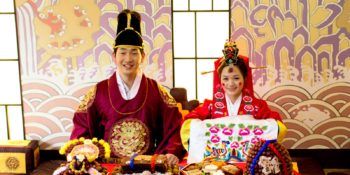
This happens a few weeks before the wedding is scheduled. First, the groom's parents make an appointment with the bride's mother and father. This meeting is taking place on neutral territory. Most often they choose a restaurant or a country cafe.
Here the elders talk, present each other with pre-prepared certificates about the state of health of the young people and the absence of hereditary diseases. This step is a manifestation of concern for the health of future children.
After this, the degree of possible relationship is determined and a decision is made on the possibility of creating a new family.
The reason for refusing the intention to enter into marriage between a boy and a girl may be their belonging to the same family.
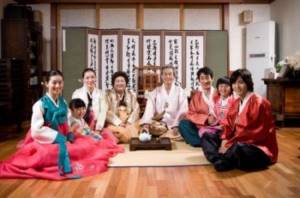
The family name inherited through the male line must not be the same. Otherwise, there can be no question of marriage. The role of matchmakers is the groom himself, his father and uncle, who come to the bride’s house accompanied by men who must know how to sing, dance and joke well.
Matchmaking in Korea is a dress rehearsal for the wedding. Close relatives and those who have separated from their spouse by filing a divorce are prohibited from attending here.
Such people can bring misfortune to the home of the young.
Another important condition for successful matchmaking is the number of accompanying people. It doesn't have to be even. According to Koreans, even numbers bring bad luck.
Only close relatives gather at the house of the bride's parents, and the matchmaking takes place without a lavish dinner.
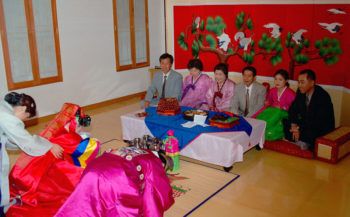
The elders agree by discussing:
- holiday details;
- number of invitees;
- ransom amount;
- bride's dowry.
The main question that the matchmakers and the girl’s parents have to answer is what day the wedding will take place.
They choose only odd numbers and try not to schedule a ceremony during a leap year.
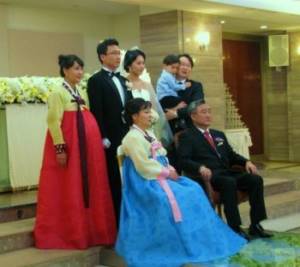
Money, jewelry and sweets are given as gifts. Only after the gifts have been distributed and everyone present has tasted the food does a serious conversation begin.
The first set date is the day of the mini-wedding. If after matchmaking a boy and a girl are called bride and groom, then after this event takes place, they are allowed to be called husband and wife.
The groom's mother is also present at the chenchi (mini-wedding), but she is not allowed to take part in the matchmaking.
Life just begins after the wedding
The morning after the wedding, the girl must show what a skilled housewife she is: prepare breakfast for the whole family and clean the house or apartment. At breakfast, all the new relatives gather, to whom the young woman presents the gifts she brought with her from her parents’ house.
A modern Korean wedding most often ends with a romantic trip to interesting places and abroad. Returning from a trip, the newlyweds always visit the girl’s parents’ house, where they thank their mother and father and spend the night. The next morning, everyone has breakfast and pays a visit to the young husband's parents, bringing with them traditional Korean dishes as a sign of respect and family unity.
Traditions of mini-wedding "chenchi" in Korea

At the request of the bride's relatives, the groom's side organizes a mini-wedding "chenchi", or, in simpler terms, a bride's party, which is a kind of test for the groom. One can only sympathize with the future spouse, since at this mini-wedding everyone present will constantly make fun of him and ask many tricky questions. The groom's relatives, in turn, must generously gift the bride, preparing in advance for this purpose pieces of beautiful material, watches, scarves and other things. Most often, gifts are targeted and each of the groom’s relatives must present his own gift to the bride.
The bride's side should respond with gratitude to the mini-celebration the next day. To do this, the bride must give gifts to all those who previously presented her with their gifts.
Features and traditions at a wedding
The main feature of a Korean wedding is that the newlyweds do not kiss at all, since this is not only not accepted in the country, but is also strictly prohibited by law. Kissing is usually replaced by eating one date or marmalade at a time. Also, according to Korean wedding etiquette, during the wedding ceremony, all guests without exception must wear white gloves.
Another distinctive feature of Korean weddings is the incredibly large number of guests, at least two hundred. It is believed that the more people come to a wedding, the higher its status. A celebration with a huge number of guests, who do not always even know each other, is considered an indicator of wealth and luxury. Despite the large number of mandatory wedding rituals, a traditional Korean wedding does not last long, since all actions are scheduled literally minute by minute; Koreans are not fans of long and drawn-out festivities.
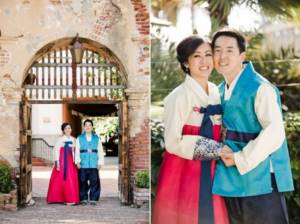
Korean wedding venue
The bride's house is usually chosen as the venue for the ceremony. Both newlyweds must wear traditional wedding attire - hanbok. The bride must wear a short vest with long sleeves on her hanbok, and the groom's hanbok, according to tradition, must be blue. Also, special red dots are pasted on the bride’s face, one on her cheeks and one on her forehead. A ceremonial platform is set up in the courtyard of the house, where the newlyweds arrive separately in special wedding niches “gamma”, which are traditionally decorated with flowers, preferably peonies as a symbol of health and a happy life together. After the official marriage, the newlyweds bow deeply to each other and drink wine from glasses that the bride’s mother must make herself from a pumpkin grown in her garden.
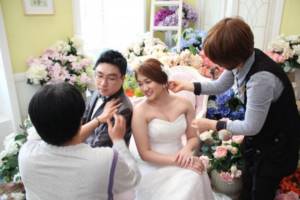
What do they give to newlyweds at a wedding in Korea?
In the modern world, Korean weddings, the traditions and customs of which have existed for centuries, are increasingly beginning to adopt European trends. This was also reflected in the gifts that are usually given to newlyweds for their wedding. Today, it is customary for newlyweds to give an envelope with money at a wedding; the amount will depend on how respectful the guest is to the newlyweds and how happy he is with their union.
Since over the past few decades, traditions have gradually begun to fade into the background, and material values have come to the fore, it is quite difficult to say what exactly, besides money, can be given to newlyweds at a Korean wedding. The groom's parents usually must give the young spouses an apartment or house where they can live as a separate family, and the bride's parents must completely furnish this house or apartment. Also, close relatives of a young couple can give gifts that will be useful to the newlyweds in everyday life: watches, dishes, etc.
Source: fb.ru
wedding
Meeting the parents of the newlyweds before the wedding
Despite the fact that Korea is a fairly progressive and developed country, and young people there have long had the right to choose their soulmate with whom they plan to connect their lives, there is one tradition. It is called “sogethin” and implies a meeting between the parents of both newlyweds to get to know each other.
This tradition is not just an act of politeness, at such a meeting the future of the newlyweds is discussed, and what participation each of the parents will take in it, financial wedding issues are also discussed. In addition, at such meetings, parents can exchange medical examination certificates for their children, since Koreans take the birth of healthy offspring quite seriously.
There is one more nuance that is necessarily discussed at such meetings, this is the family background of the future spouses - mon. Pon is a family estate, which is inherited through the male line and represents a kind of settlement association. If it turns out that the newlyweds are from the same Pon, they will not be able to get married, in which case everything is cancelled. If the young people are from different backgrounds, their health is fine, and the parents were able to come to a common agreement regarding the organization of the wedding and the future fate of the future family, then soon matchmakers are sent to the bride.
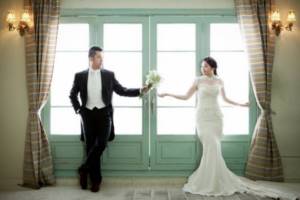
Korean wedding dresses: modern or traditional
The traditional Korean wedding dress is the hanbok. It consists of a shirt (jegori) and a skirt (chhima). Today, more and more brides are preparing two outfits for the celebration: for the official ceremony itself - a national costume, for the celebration - a classic wedding dress. Although many designers meet girls halfway and sew modern hanboks, while preserving traditional motifs. Korean wedding dresses are sewn in such a way as to emphasize the fragility and tenderness of the bride. The photo below shows outfit options for newlyweds at a Korean wedding.
You can get acquainted with the traditions of marriage in other cultures - at a European, American or Chinese wedding, on the wedding portal www.svadbagolik.ru. We hope you found this article useful and interesting!
